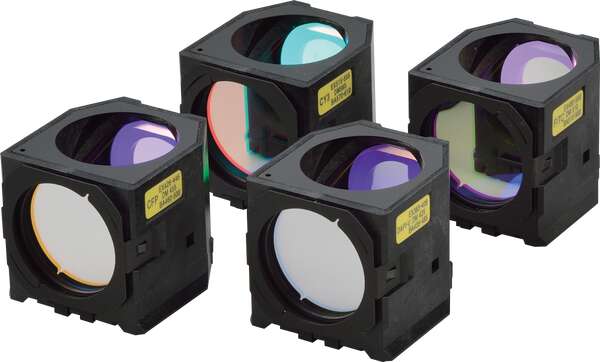
Laser Components offers a comprehensive range of fluorescence filter sets from our partner Omega Optical. Standard sets are available for over 180 dyes and fluorophores. Long pass emission sets and narrowband sets are available for samples with multiple tags. Check Fluorescence microscopy filters for more.
Fluorescence sets typically consist of an excitation filter selecting the range of excitation wavelengths, a dichroic mirror and an emission filter blocking the excitation light. The excitation filter is a band-pass which transmits the desired wavelengths and reflects or absorbs the unwanted wavelengths. The transmitted light is reflected through 45° by the dichroic mirror, directing the excitation wavelengths to the sample and allowing the emission to transmit back though. Finally, the emission filter blocks the excitation light and transmits the desired fluorescence to the detector. These filters produced by Omega Optical are characterised by good blocking out of band and high transmission of desired wavelengths to produce a good quality image with a high signal-to-noise ratio.
Filter sets, components, and holders are available for all major microscope manufacturers and models, including Leica, Nikon, Olympus, and Zeiss.
See Cells In A New Light With A DIY Fluorescence Microscope
Ever since a Dutch businessman peered into the microscopic world through his brass and glass contraption in the 1600s, microscopy has had a long, rich history of DIY innovation. This DIY fluorescence microscope is another step along that DIY path that might just open up a powerful imaging technique to amateur scientists and biohackers.
In fluorescence microscopy, cells are treated with various fluorescent dyes that can be excited with light at one wavelength and emit light at another. But as [Jonathan Bumstead] points out, fluorescence microscopes are generally priced out of the range of biohackers. His homebrew scope levels the playing field a bit. The trick is to use 3D-printed parts to kit out commonly available digital cameras – a USB microscope, a DSLR, or even a smartphone camera. Excitation is provided by a ring of Nexopixel LEDs, while a movable rack holds a filter that blocks the excitation wavelength but allows the emission wavelength to pass through to the camera. He demonstrates the technique by staining some threads with fluorescent ink from a highlighter marker and placing them on a sheet of tissue paper; in conventional bright-field mode, the threads all but disappear into the background, but jump right out under fluorescence.
It’s true that the optics are not exactly lab quality, and the microscope is currently only set up to do reflectance imaging as opposed to the more typical transmissive mode where the light passes through the sample. That’s an easy fix, though, and reflectance mode is still useful. We’ve seen fluorescence microscopy get quite complex before, but this simple scope might be enough to get a biohacker started.






More Stories
Chinese Naval Hobie Cat Catamaran War Ship – Yet Another Copy
Profile of a Mass Murderer
Artificial Intelligence and Machine Learning Basics